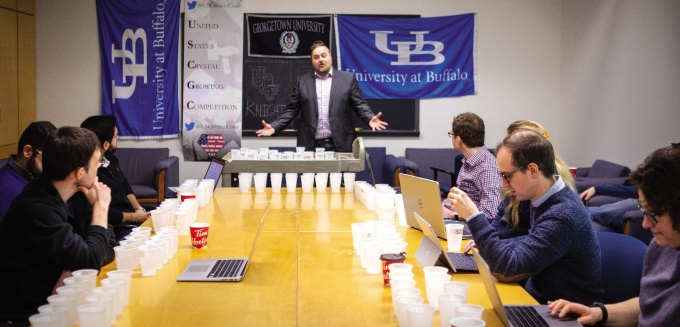Outreach

Prof. Jason Benedict (center) at the start of the judging of the 2018 U.S. Crystal Growing Competition.
2018 U.S. Crystal Growing Competition
“We restructured our curriculum to accommodate crystal growing and it made for a fun year. Can’t wait to do this again!” – Excerpt from thank you note from educator Laura McMillen of Powdersville High School in Greenville, South Carolina.
I’ve said it before, and I’ll say it again: Kids and teachers love growing crystals! Nearly 260 teams from schools and households in 42 states (up from 160 teams in 36 states in 2017) signed up for the fifth running of U.S. Crystal Growing Competition (USCGC, uscrystalgrowingcompetition.org). Hundreds of kilograms of alum went out, and over 150 crystals were sent back to the University at Buffalo (UB)! In fact the contest is growing so much, we welcomed a new assistant, Tasha Benedict (UB)! And we’re sending out so much alum that some of it is now being shipped by the three regional coordinators: Michael Nippe (Texas A&M University, TAMU), Fernando Uribe-Romo (University of Central Florida, UCF) and Karah Knope (Georgetown University, GU). Sponsored in part by American Crystallographic Association (ACA), the USCGC continues to bring the science of crystals into America’s classrooms. As we’ve observed previously, the crystal growing abilities of the participants continue to improve! The 2018 USCGC, which once again began during National Chemistry Week in mid-October and concluded in early December, was judged by a number of veteran judges that included UB Professors from Chemistry: Timothy Cook, Ekin Atilla-Gokcumen, David Lacy, and Luis Velarde.The contest welcomed back veteran USCGC judge Andrea Markelz, UB Professor of Physics. The contest was aided by some new judges:
Graduate students Nicole Vanagas (GU), James Vanjak (TAMU), and Demetrius Vazquez-Molina (UCF).
Social media remains one of our best tools for advertising and providing contest updates! The winners were announced via the contest Twitter account, @USCrystalComp. Check out all the winners and some great participant posts (e.g. Jim Burdick’s dissolving crystal data!) at #2018USCGC on Twitter!
The USCGC helps raise public awareness of the importance of crystal-based research and the organizations, including the ACA, that promote and support these important activities.
The USCGC gratefully acknowledges the Benedict Research Group graduate students, and the support of our sponsors: ACA, National Science Foundation, Ward’s Scientific/VWR, Bruker AXS, Krackeler Scientific, Cambridge Structural Data Centre, the Western New York section of the American Chemical Society, the Departments of Chemistry of UB, GW, UCF, and TAMU. Please consider donating to the 2019 contest:
For more information, please visit the USCGC website or e-mail Jason Benedict at jbb6@buffalo.edu.
- Jason Benedict

All entries are on display on the 7th floor of the Department of Chemistry Natural Sciences Complex at the University at Buffalo.
Interdisciplinary Science and Engineering Partnership (ISEP) with Buffalo Public Schools
Launched and led by Prof. Joseph A. Gardella, Jr., ISEP was founded in 2005 with funding from the local John R. Oishei Foundation. A coalition of partners in Western New York State received a five-year, $9.8 million grant from the National Science Foundation (NSF) to expand the Interdisciplinary Science and Engineering Partnership (ISEP) in 2011. Supported with resources totaling more than $10 million, this program aims to transform how science is taught in the highest need schools in the Buffalo Public School District by increasing hands-on learning. The focus of ISEP is the critical middle school experiences of students in science and engineering, as they transition to high school. The project uses an innovative approach to teacher professional development among high-needs
urban schools (including "feeder" middle schools and their corresponding high schools).
This is accomplished through courses and interdisciplinary research experience, development of science and technology classroom materials aligned with state science learning standards, and inquirybased curricula. Sample research topics include nanotechnology, molecular biology, pharmacokinetics, robotics, cancer research, computer science, English as a second language, earthquake engineering, and response to natural and manmade emergencies— to name just a few. The commitment of the Department of Chemistry has been a central aspect of the ISEP program. A dozen chemistry faculty hosting teachers for professional development and over twenty Chemistry graduate students, along with nearly 50 chemistry undergraduates, have participated in ISEP.
The ISEP model combines the efforts of higher education, informal science, community organizations and corporate partners to ultimately improve science education. Through the use of novel mentoring approaches and expanded Professional Learning Communities, ISEP cultivates lifelong mentoring relationships involving middle and high school teachers and students, UB and Buffalo State College science/ engineering/ technology faculty, undergraduate and graduate students, local industry professionals and parents. Since its inception, ISEP has served over 9,000 students and hundreds of teachers.
Using the ISEP framework, an Innovative Technology Experiences for Teachers and Students (ITEST) grant was secured and an existing Geo-technology Experiences for Students and Teachers (GTEST) camp was expanded to teach Geographical Information Systems (GIS) skills to teachers and students in a co-learning format. Moving forward, ISEP is focusing on working with corporate partners to address the future of our workforce and is helping to instill computer science in curriculum.

Prof. Joseph Gardella works with Native American Magnet School 19 students.
ISEP continues to work handin- hand with the Buffalo Public Schools, practicing the importance of wraparound, year-round support for teachers & their professional learning, family and parent support, and hands-on, inquirybased scientific learning for students.
As a result of the first 10 years of ISEP,
there were:
• Improvements in student STEM learning as shown in test results, graduation rates, and surveys;
• Improvements in teachers’ knowledge of interdisciplinary science and content related to Common Core and Next Generation Science Standards;
• Development of hundreds of new classroom and after school activities; OUTREACH
• Development of a national model for parent involvement in STEM education; and
• Recognition by the national STEM Funders Network and the White House.
Isep.buffalo.edu
Isep.buffalo.edu/gtest
Facebook & Twitter: @ISEPBuffalo